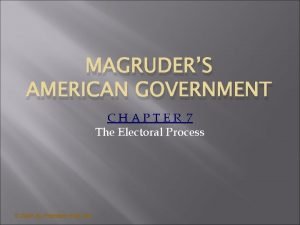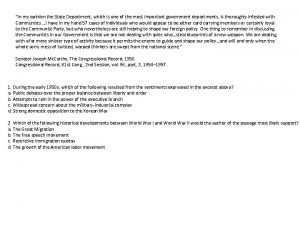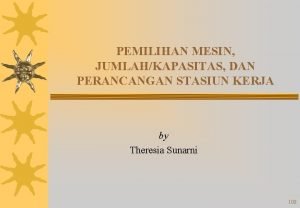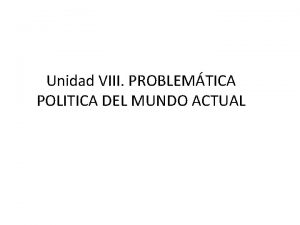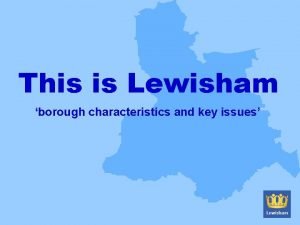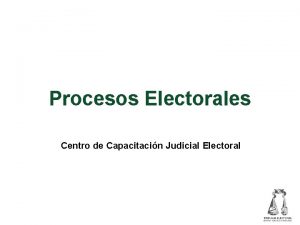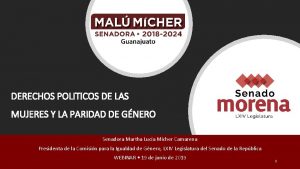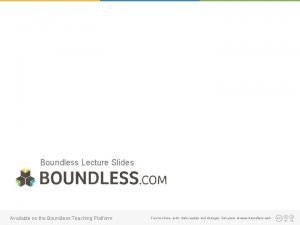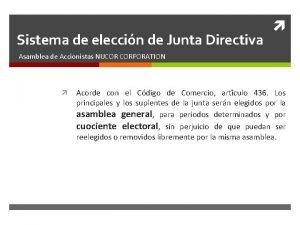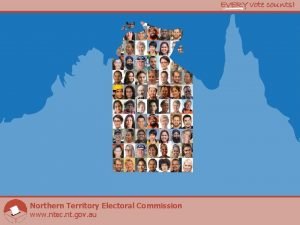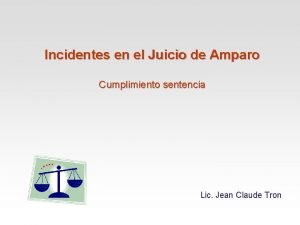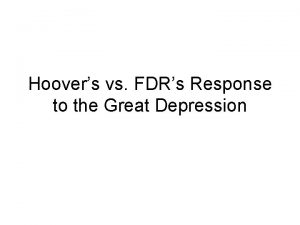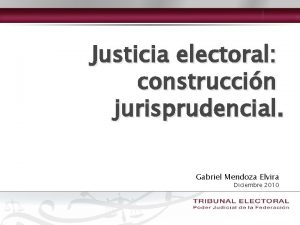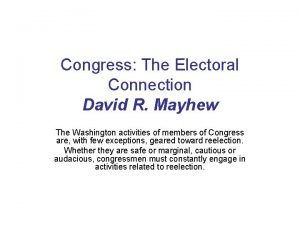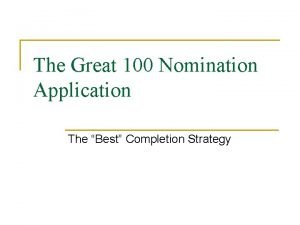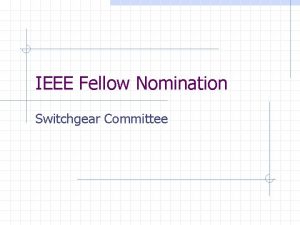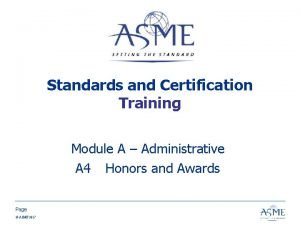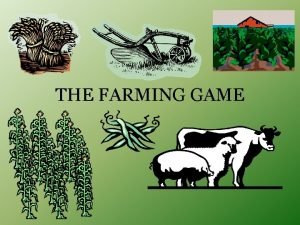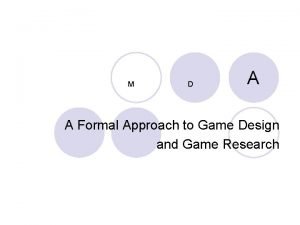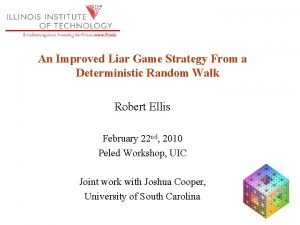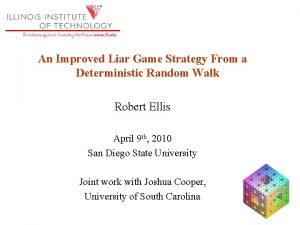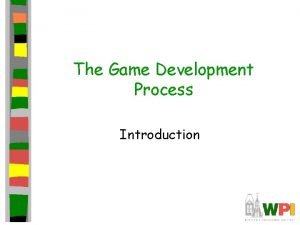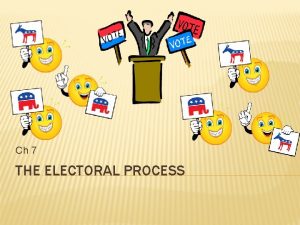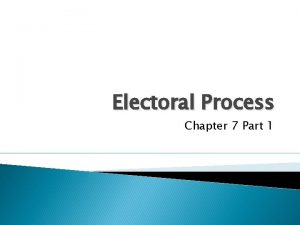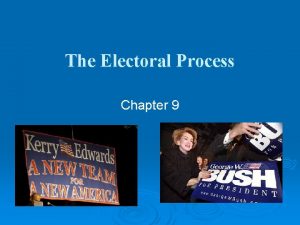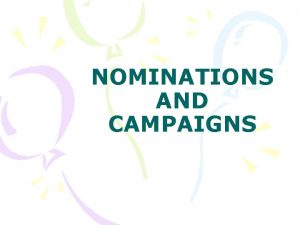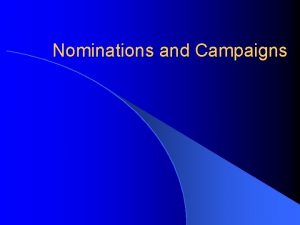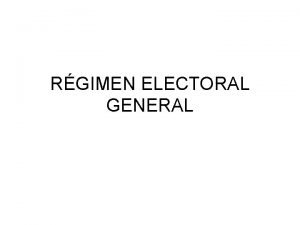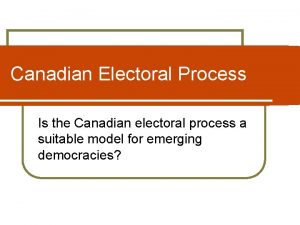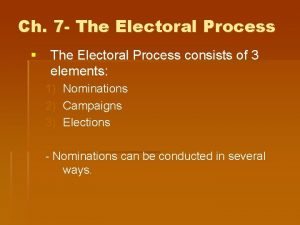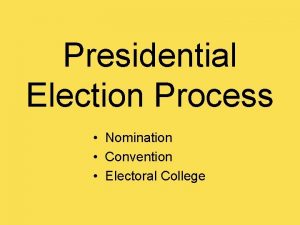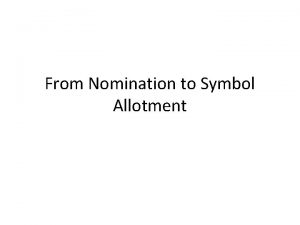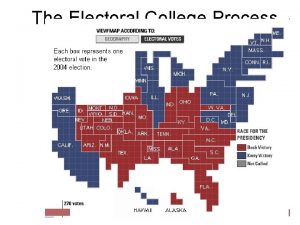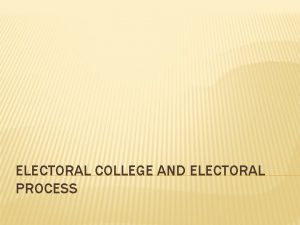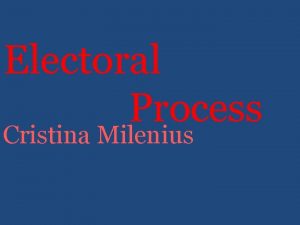The Electoral Process The Nomination Game Nomination The


















































- Slides: 50

The Electoral Process

The Nomination Game • Nomination – The official endorsement of a candidate for office by a political party – Generally, success requires momentum, money, and media attention. • Campaign Strategy – The master game plan candidates lay out to guide their electoral campaign

The Nomination Game • Deciding to Run – Campaigns are more physically and emotionally taxing than ever. – American campaigns are much longer. • Barack Obama made clear his intention to run for president in January 2007. • Other countries have short campaigns, generally less than two months.

The Nomination Game • Competing for Delegates – Nomination game is an elimination contest – Goal is to win a majority of delegates’ support at the national party convention, or the supreme power within each of the parties • The convention meets every four years to nominate the party’s presidential and vice-presidential candidates. • Conventions are but a formality today.

The Nomination Game • The Convention Send-off – National conventions once provided great drama, but now are a formality, which means less TV time. – Significant rallying point for parties – Key note speaker on first day of Convention – Party platform: statement of a party’s goals and policies for next four years • Debated on the second day of the Convention – Formal nomination of president and vice-president candidates on third and fourth days

The Nomination Game

Function of the Election • Choose over 500, 000 public roles • Contest between political parties • Winner-take-all – the person with the most votes wins (don’t need over 50%) – Plurality – Single-member districts – one rep per district

• State. Total Population/ • Electoral Votes • Alabama 4, 447, 100 • 9 • Georgia 8, 186, 453 13 • Alaska 626, 932 3 • Hawaii 1, 211, 537 4 • Arizona 5, 130, 632 8 • Idaho 1, 293, 953 4 • Arkansas 2, 673, 400 6 Illinois 12, 419, 293 22 • California 33, 871, 648 54 • • • Indiana 6, 080, 485 12 • Colorado 4, 301, 261 8 • Iowa 2, 926, 324 7 • Connecticut 3, 405, 565 8 • Delaware 783, 600 3 • Dist. of Columbia 572, 059 3 Florida 15, 982, 378 25

• Kansas 2, 688, 418 • • Kentucky 4, 041, 769 6 • Missouri 5, 595, 211 11 8 • Montana 902, 195 3 • Louisiana 4, 468, 976 9 • Nebraska 1, 711, 263 5 • Maine 1, 274, 923 4 • Nevada 1, 998, 257 4 • Maryland 5, 296, 486 10 • New Hampshire 1, 235, 786 4 • Massachusetts 6, 349, 097 12 • New Jersey 8, 414, 350 15 • Michigan 9, 938, 444 18 • New Mexico 1, 819, 046 5 • Minnesota 4, 919, 479 10 • Mississippi 2, 844, 658 7

• • • New York 18, 976, 457 North Carolina 8, 049, 313 North Dakota 642, 200 Ohio 11, 353, 140 Oklahoma 3, 450, 654 Oregon 3, 421, 399 Pennsylvania 12, 281, 054 Rhode Island 1, 048, 319 South Carolina 4, 012 South Dakota 754, 844 33 14 3 21 8 7 23 4 8 3

• • • Tennessee 5, 689, 283 Texas 20, 851, 820 Utah 2, 233, 169 Vermont 608, 827 Virginia 7, 078, 515 Washington 5, 894, 121 West Virginia 1, 808, 344 Wisconsin 5, 363, 675 Wyoming 493, 782 11 32 5 3 13 11 5 11 3

Presidential Election Process 1. Each state holds a primary or caucus between January and June to determine candidates for parties 2. Candidates then enter into general elections against the other political parties - More people vote in general elections. In 2004, 50% of people voted in general elections versus 25% in the primaries.

Congressional Elections vs. Presidential Elections • Congress elections are regional – Senate by state; House by district • House elections are less competitive than Senate or President – Incumbents – rep up for reelection, typically win elections by 60% • Congressional elections every two years (all House up for reelection and 1/3 of the Senate) Fewer people vote in “off-year” or “midterm year” (only 36%) which means voters are more activist or ideological

1. The Nominating Process – Nomination The naming of those who will seek office. – General Elections regularly scheduled elections at which voters make the final selection of officeholders.

2. Various Nomination Methods • Self-Announcement, Caucus, Convention, Direct Primary, Petition – Self-Announcement • • A person who wants to run for an office simply announces that fact. Whenever a write-in candidate appears in an election, the self-announcement process has been used. Still used on small-town and rural levels. The last famous presidential candidate was Ross Perot in 1996.

3. Various Nomination Methods – The Caucus • Caucus a group of like-minded persons who meet to select the candidates they will support in an upcoming election. • In the beginning the caucus was a private meeting consisting of a few influential figures. • Political parties expanded the influence of the caucus. The caucus has all but disappeared from politics. •

5. Various Nomination Methods The Delegate Convention • Replaced the Caucus. Started in 1831. • On paper, the convention process seems perfect for representative gov’t. • In practice, the convention process was exposed as being a corruptible process. • Party bosses found ways to manipulate the selection of delegates and dominate entire systems.

6. Various Nomination Methods • Direct Primary an election held within the party to pick the party’s candidates for the general election. • Wisconsin adopted the first Statewide direct primary law in 1903 and several other states soon followed. • Primaries are closely regulated by most States. • The State, not the parties, provides polling places and election officials.

7. Various Nomination Methods • Two different types of primaries = Closed & Open. • Closed Primary Only qualified voters who are also party members can vote. • Open Primary Any qualified voter can vote.

7. Various Nomination Methods • Presidential primaries are elections in which voters express candidate preferences or select delegates to the national convention. • Petition—voters canvas towns and cities to gather signatures to place their candidate(s) on the ballot.

8. Elections • Democratic government cannot succeed unless elections are free, honest, and accurate. • When are elections held? ? • The first Tuesday after the first Monday of November of every evennumbered year.

9. Elections • Coattail Effect When a strong candidate running for an office at the top of the ballot helps attract voters to other candidates on the party’s ticket. • This can happen for the (+) and the (-). • Example: I really liked George Bush Jr. so I’ll vote for other Republicans.

10. Elections • Precinct A voting district. • These are the smallest geographic units for the conduct of elections. • State law regularly restricts their size, generally to an area with no more than 500 to 1, 000 or so qualified voters.

11. Elections • A polling place (where voters actually go to vote) is located somewhere in or near each precinct.

12. Elections • Ballot the device by which a voter registers a choice in an election. – Ballots can look many different ways. – Many American ballots can be confusing to even the most educated voters. – Electric voting machines are being used in some states. » Florida in 2000 led to complications because holes in the ballots were not completely punched out.



13. Electoral College • An electoral college is a set of electors who elect someone to a particular office. • Many times, though, the electors are simply important persons whose wisdom, it is hoped, would provide a better choice than a larger body.

14. Electoral College vs. Popular Vote • There is an anomaly to the electoral college system that can result in a candidate winning the presidency by winning the majority of the electoral vote even if he fails to win the popular vote. • In 1876, Rutherford B. Hayes won 185 electoral votes to Samuel Tilden's 184, but Tilden won a majority of the popular vote with 4, 300, 590 cast in his favor versus 4, 036, 298 cast for Hayes. • In 1888, Benjamin Harrison won 233 electoral votes to Grover Cleveland's 168, with 5, 439, 853 popular votes for Harrison and 5, 540, 309 for Cleveland.

14. Electoral College vs. Popular Vote • In 2000, George W. Bush won 271 electoral votes to Al Gore's 266, with 50, 456, 062 popular votes for Bush and 50, 996, 582 votes for Gore. • After this most recent occurrence in 2000, there were many calls for the elimination of the electoral college system in favor of a direct popular vote for the presidency. • However, such a reform would require a constitutional amendment.


• Should the electoral college exist? Why or why not? • What are the positives/negatives of the electoral college? • Is the average voter well informed to make a rational vote for the presidential candidate? Why or why not?

Elections

Money and the Election Process In 1996 total spending for all of the major and minor party efforts approached $750 million. What does this $ get spent on? ? Answer: Radio and TV time, campaign managers and consultants, newspaper ads, pamphlets, buttons, posters, etc. Television commercials are by far the most costly portion.

Money and the Election Process • At the federal level, the primary source of campaign funds is individuals; political action committees are a distant second. • Contributions from both are limited. • These regulated donations are often referred to as hard money.

Money and the Election Process • Corporations and unions are prohibited from contributing directly to a candidate's campaign. • Soft money are funds spent by organizations that are not contributed directly to candidate campaigns, and which do not "expressly advocate" the election or defeat of a candidate. • Bundling is the practice of one donor gathering donations from many different individuals in an organization or community and presenting the sum to a campaign.

Sources of Campaign Funding • Private Givers: Represent the major source of campaign funds in the U. S. • The limitation upon personal contributions from any one individual. ($2, 300 in 2007) • Private givers fall into 5 categories • Small Contributors those who give $5 or $10 occasionally.

Money and the Election Process • Wealthier Persons and Families “Fat Cats”, who can afford to make large donations usually in their best interest. • Candidates themselves Example: Ross Perot • Political Action Committees (PACs) Special interest groups that have a stake in public policy

Money and the Election Process • Large Industry PAC’s: • Agriculture • Business - Retail, Services • Communication, Technology • City/County • Defense • Energy, Natural Resources • • • Finance, Insurance Foreign Countries Health Care Organized Labor Law Manufacturing Public Employees Real Estate/Construction Transportation

Money and Campaigning

Money and the Election Process • • • Major Single Issue Lobbies Pro-Life/Pro-Choice (Abortion) Democratic Party Environment Federal leadership Human Rights Foreign & Defense Policy Gun Rights/Gun control Israel Republican Party

Money and the Election Process • In the 2004 elections, the top 10 PACs by money spent by themselves, their affiliates and subsidiaries were: • • • EMILY's List $22, 767, 521 Service Employees International Union $12, 899, 352 American Federation of Teachers $12, 789, 296 American Medical Association $11, 901, 542 National Rifle Association $11, 173, 358 Teamsters Union $11, 128, 729 International Brotherhood of Electrical Workers $10, 819, 724 National Education Association $10, 521, 538 American Federation of State, County and Municipal Employees $9, 882, 022 • Laborers' International Union of North America $9, 523, 837

Money and the Election Process • EMILY's List is a (PAC) that aims to help elect prochoice Democratic women to office. • Service Employees International Union (SEIU) is a labor union representing 1. 8 million workers in about 100 occupations in the United States and Canada. • The American Federation of Teachers (AFT) represents teachers; paraprofessionals and schoolrelated personnel; local, state and federal employees; higher education faculty and staff; and nurses and other healthcare professionals.

Money and the Election Process • The American Medical Association (AMA) is the largest association of medical doctors in the United States. • The National Rifle Association, or NRA, is a group for the promotion of marksmanship, firearm safety, and the protection of hunting and personal protection firearm rights in the United States.

Money and the Election Process • Temporary Organizations Groups created for fund-raising purposes. Example: “Victory ‘ 96” was a pro-Dole-Kemp org.

Money and the Election Process • Why do people give? ? • Some people donate because they feel strongly for a candidate. • Sometimes people give large donations so that they may be “taken care of” if that person gets into office.

Money and the Election Process • The Federal Election Commission (FEC) • Forces candidates to do these four things: – Require the timely disclosure of campaign finance data – Place limits on campaign contributions – Place limits on campaign expenditures – Provide public funding for several parts of the presidential election process.

Money and the Election Process • The role of PAC’s (political action committees) – There are over 4, 000 PAC’s in the U. S. – PAC’s are made up of executives, stockholders, union members, doctors, dentist or teachers. – Each group supports a certain ideological view on given issues.

Presidential Campaigns • The Dole-Clinton campaigns each received $61. 3 million from the FEC. • Each spent an estimated $232 million dollars campaigning • For fed. , state, and local elections combined in 1996, campaign spending was estimated at $4. 1 billion.

Presidential Campaigns – In 2004 Bush & Kerry each received $74. 6 million in government funding. – If a minority party wins 5% of the popular vote they become eligible for public funding.
 Chapter 7 the electoral process
Chapter 7 the electoral process The 1964 electoral map above illustrates the
The 1964 electoral map above illustrates the Election machine
Election machine Geografía electoral
Geografía electoral Largest borough
Largest borough Geografía electoral
Geografía electoral Materia electoral
Materia electoral Electoral college changes
Electoral college changes 1992 electoral map
1992 electoral map Electoral college compromise 1787
Electoral college compromise 1787 Ejemplo cuociente electoral junta directiva
Ejemplo cuociente electoral junta directiva Northern territory electoral commission
Northern territory electoral commission Tipos de incidentes en materia electoral
Tipos de incidentes en materia electoral Hoover v. fdr: responses to the great depression
Hoover v. fdr: responses to the great depression Bodega electoral
Bodega electoral Que es el flujograma de documentos electorales
Que es el flujograma de documentos electorales Justicia electoral mendoza
Justicia electoral mendoza Electoral connection definition
Electoral connection definition Cuerpo electoral significado
Cuerpo electoral significado Great 100 nurses nomination examples
Great 100 nurses nomination examples Ieee fellow nomination
Ieee fellow nomination Moe echa award
Moe echa award Asme fellow nomination
Asme fellow nomination Levine scholarship deadline
Levine scholarship deadline The pirate game
The pirate game The farming game rules
The farming game rules A formal approach to game design and game research
A formal approach to game design and game research Game lab game theory
Game lab game theory Liar game game theory
Liar game game theory Liar game game theory
Liar game game theory Game development process
Game development process Video game development timeline
Video game development timeline Game making process
Game making process The westing game introduction
The westing game introduction Game development process flowchart
Game development process flowchart Hình ảnh bộ gõ cơ thể búng tay
Hình ảnh bộ gõ cơ thể búng tay Lp html
Lp html Bổ thể
Bổ thể Tỉ lệ cơ thể trẻ em
Tỉ lệ cơ thể trẻ em Chó sói
Chó sói Chụp tư thế worms-breton
Chụp tư thế worms-breton Hát lên người ơi alleluia
Hát lên người ơi alleluia Môn thể thao bắt đầu bằng từ chạy
Môn thể thao bắt đầu bằng từ chạy Thế nào là hệ số cao nhất
Thế nào là hệ số cao nhất Các châu lục và đại dương trên thế giới
Các châu lục và đại dương trên thế giới Công thức tính thế năng
Công thức tính thế năng Trời xanh đây là của chúng ta thể thơ
Trời xanh đây là của chúng ta thể thơ Cách giải mật thư tọa độ
Cách giải mật thư tọa độ Phép trừ bù
Phép trừ bù Phản ứng thế ankan
Phản ứng thế ankan Các châu lục và đại dương trên thế giới
Các châu lục và đại dương trên thế giới
